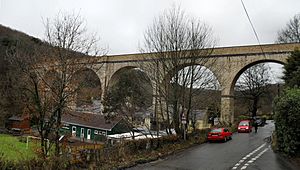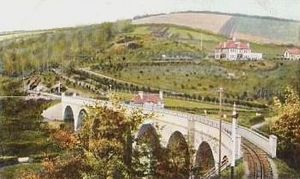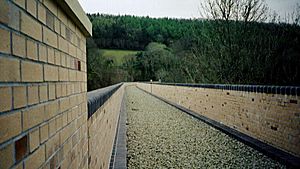Chelfham Viaduct facts for kids
Quick facts for kids Chelfham Viaduct |
|
|---|---|

Chelfham Viaduct (2010)
|
|
| Coordinates | 51°06′14″N 3°59′13″W / 51.10388°N 3.98690°W |
| Crosses | Stoke Rivers Valley |
| Locale | Chelfham, North Devon |
| Heritage status | Grade II listed structure |
| Characteristics | |
| Material | Brick |
| Total length | 400 feet (120 m) |
| Height | 70 feet (21 m) |
| History | |
| Designer | F. W. Chanter |
| Opened | 1898 |
| Closed | 1935 |
The Chelfham Viaduct is a large railway bridge built in 1896-1897. It was made to carry the Lynton and Barnstaple Railway (L&B) across the beautiful Stoke Rivers valley. An engineer named F.W. Chanter designed this amazing structure. It's made from over 250,000 special Marland bricks!
This viaduct has eight big arches. Each arch is about 13 meters (42 feet) wide and 21 meters (70 feet) high. The whole viaduct is about 121 meters (132 yards) long. This makes it the biggest structure of its kind for a narrow gauge railway in England. The Chelfham Viaduct was bridge number 22 out of 80 bridges on the L&B railway line. In 1965, it was recognized as a special historic building. This means it is protected as a Grade II structure.
What Happened After the Railway Closed?
The Lynton and Barnstaple Railway closed down in 1935. Most of the railway's land and buildings were sold in 1938. But the Chelfham Viaduct was not sold.
In 1943, the viaduct was used in a movie called The Flemish Farm. It pretended to be a border crossing between France and Spain. Usually, old bridges like this would be taken apart. This often happened during World War II. For example, a smaller bridge nearby was destroyed for army training.
However, the Chelfham Viaduct was not taken down. There was a school and other buildings at its base. This made it too expensive to dismantle. So, it stayed standing. It was owned by the Southern Railway company. Later, it became part of British Railways when railways were nationalized in 1948.
Bringing the Viaduct Back to Life
In the year 2000, the Chelfham Viaduct was fixed up. Workers added a special waterproof layer to its top. They also improved how rainwater drained away. The sides of the bridge were also repaired.
Now, the viaduct is ready to carry trains again! This repair project was paid for by British Railways Board and the Railway Heritage Trust. The Lynton and Barnstaple Railway Trust also helped. They own the nearby railway station. They hope to reopen the railway line in the future.
Images for kids






